Faces of Astronomy for Development
By Karabo Makola and Ramasamy Venugopal
Astronomy is very special to all of us and the Global Astronomy Month (GAM) provides a great opportunity for everyone to celebrate our common love. Usually the OAD’s contribution to the GAM blog is written by Kevin Govender. This year, the blog is a retrospective from two visitors to the OAD. Both of us came from outside the astronomy community but have learned so much during our time at the OAD. Most importantly, we have realized the passion and thirst for action in this community and learned how people, given the opportunity, can have a tangible impact on the world.
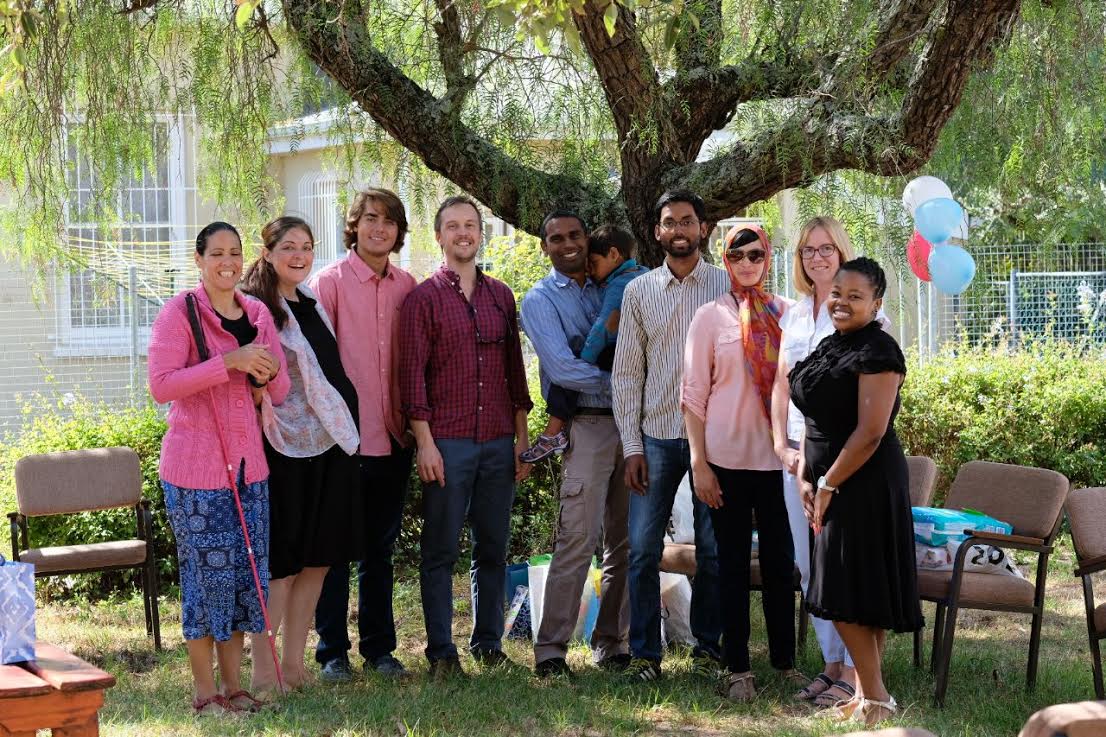 Faces of the OAD from left are Wanda Diaz-Merced, Eli Grant, Jack Harvey (former intern), Paul A. Wilson, Kevin Govender, Ramasamy Venugopal, Nuhaah Solomon,Vanessa McBride, and Karabo Makola.
Faces of the OAD from left are Wanda Diaz-Merced, Eli Grant, Jack Harvey (former intern), Paul A. Wilson, Kevin Govender, Ramasamy Venugopal, Nuhaah Solomon,Vanessa McBride, and Karabo Makola.
The OAD and the community it works with have a big task on their hands - to use astronomy to create a better world. Since the beginning, the need for a wide network and collaboration with institutions globally and across multiple fields was evident as was the requirement for a wide range of skills. The OAD has thus encouraged volunteers with varied skills to contribute to the IAU’s vision of development using astronomy. This has led to numerous visitors, either popping in to work at our Cape Town offices or collaborating with us remotely, joining the OAD staff for different periods of time.
The Office has in recent times seen unprecedented growth in the addition of new team members from a wide range of disciplines. In 2016 alone, there were/are 10 people that the Office hosted/is hosting in different capacities. These people were/are hosted as interns, volunteers, and postdoctoral researchers stemming from fields ranging from astrophysics to communications and everything in between.
Dr. Wanda Diaz-Merced is an astrophysicist from Puerto Rico who is developing tools and methods to teach science to people with different learning modalities. Wanda herself lost her sight as a student and performs her research by converting data into sound.
Dr. Paul A Wilson is a visiting astronomer from Norway who is passionate about data science and is creating a toolkit that will enable data science to be taught using astronomy. Data science is a critical component in social science and development fields and is a clear way for astronomy and astronomers to contribute.
Alex Gagliano and Jack Harvey were volunteers from the USA who helped the OAD in the critical and difficult task of consolidating and organizing data from all its funded activities. Their work is a critical part of our new call for proposals (to be announced soon).
Dr. Tara Batista, a visiting fellow from the USA, worked on evidence synthesis in education interventions along with OAD staffer Dr. Eli Grant
Jamie Ferguson is a PhD student from Scotland studying multimodal technologies that will allow astronomical data to be perceived through sound – with the goal of opening up astronomy to those with sensory disabilities. He visited the office as part of his research and collaboration with Dr. Diaz-Merced
Sahar Mohy-Ud-Din, a visiting fellow, is developing an ethics framework for the OAD as well as creating resources on project design and outcome measurements
Several PhD students from the University of Cape Town have also been active contributors over many years. Rajin Ramphul is our in-house programmer and has organized workshops to teach python programming. As a PhD student, Dr. Laure Catala led the AstroVarsity project, an effort to use astronomy to enhance teaching of physics and mathematics at university level.
This sample of people does not include our regular collaborators, both home and abroad, nor does it include our partners, regional offices, task forces, steering committee and many, many others who have made the office what it is today. However, this sample does illustrate a point: this is a highly interdisciplinary field requiring a wide skillset. The office also benefits immensely from the interactions with visitors of such diverse cultural, social and geographical backgrounds. A complete list of everyone who visited/interned at the OAD (with a short summary of their work) is available on our website.
Over the years, the OAD has come to act as a bridge between the astronomers and astronomy outreach community on the one hand, and social scientists and development experts on the other (and everyone else in between). Astronomy is a special field where non-astronomers play a significant role. There is a place for everyone, from graphic designers to programmers, web developers to educators, engineers to artists, film makers, physicists, scientists, etc. If you think you can contribute to the vision of ‘’Astronomy for a Better World’’, please contact us.
Ramasamy Venugopal
Ram is an engineer from India specializing in telecommunications. After completing his masters from the International Space University, he moved into the field of Astronomy and Space. Currently, he is a visiting fellow, managing projects at the OAD as well as a volunteer with World Space Week and Space Generation Advisory Council.
Karabo Makola
Karabo is a communications intern at the OAD. She graduated from the University of Limpopo with a BA Honours in Media Studies majoring in Journalism and Communication Studies. She joined the OAD in May 2016 to assist with publications and all communication activities within the office and with various stakeholders.
Can you find the speed of light yourself?
By Samir Dhurde
 a representative image
a representative image
If you diligently do the previously mentioned study of the motions of the Galilean Moons, then you may want to continue a bit more on the lines of an important study that lead to one of the first, close-to-accurate measurements of the speed of light... and this is the best time to start trying the method yourself!
Extraordinarily Fast
Before the 17th century we believed that there was no such thing as the "speed of light". It was thought that light could travel any distance in no time at all. In 1638, the great Galileo Galilei was probably the first person to try to determine the speed of light. His experiments however were conducted over small distances on the Earth and the timing instruments available to him were not very precise. Hence, he could only confirm that the propagation of light is "if not instantaneous, then extraordinarily fast". Today we know that, given such short distances and the very great speed of light, it was quite remarkable that he at least tried.
Olé! Another Cheer for Astronomy
Back in the mid-1600s astronomers were measuring the orbital periods of Jupiter's four largest moons. They too were using the convenient period of the Opposition of Jupiter for these measurements. However, when they timed the same after the Opposition, they were in for a surprise. When fairly close to what is called the “Conjunction of Jupiter”, about six months after Opposition, astronomers found the predicted eclipses & transits to be consistently late by upto 22 minutes. Strangely these would get back on schedule at Opposition! This created a new mystery.
| The Danish astronomer Ole Rømer, working at the Paris Observatory, was compiling extensive observations of the orbit of Io. By timing the eclipses of Io, Roemer hoped to determine a more accurate value for the satellite’s orbital period. Accurate time pieces did not exist at that time and such observations had a practical importance of providing a clock in the sky! It would enable navigators anywhere in the world to compare prediction tables with this clock using telescopes for knowing the absolute time at their home city and calculating their current longitude. |  |
| A Danish postage stamp celebrating the hero astronomer Ole Roemer |
In 1675, while mulling over the puzzling changes in timings, Rømer thought of an explanation that countered the age old prevalent assumption - that light could travel any distance in no time at all. He surmised that if light travels at a finite speed and we see things because of their light, then the further away we are from an object, the greater is the time delay in our viewing of that object. He further concluded that the different timings for the satellites’ eclipses reflected the different distances light had to travel. The light from the Jupiter system has to travel a longer path to reach the Earth when the two planets were on opposite sides of the Sun (Conjunction) than when they are closer together (Opposition). He thus reasoned that light must take 22 minutes to travel a distance equal to the diameter of Earth's orbit, thus putting its speed at about 220,000 km/s in modern units. This unimaginable speed measurement was a big feat and wasn't bettered until 150 years later by Hippolye Fizeau! Modern ways of timing show that this delay is slightly less than 17 minutes.
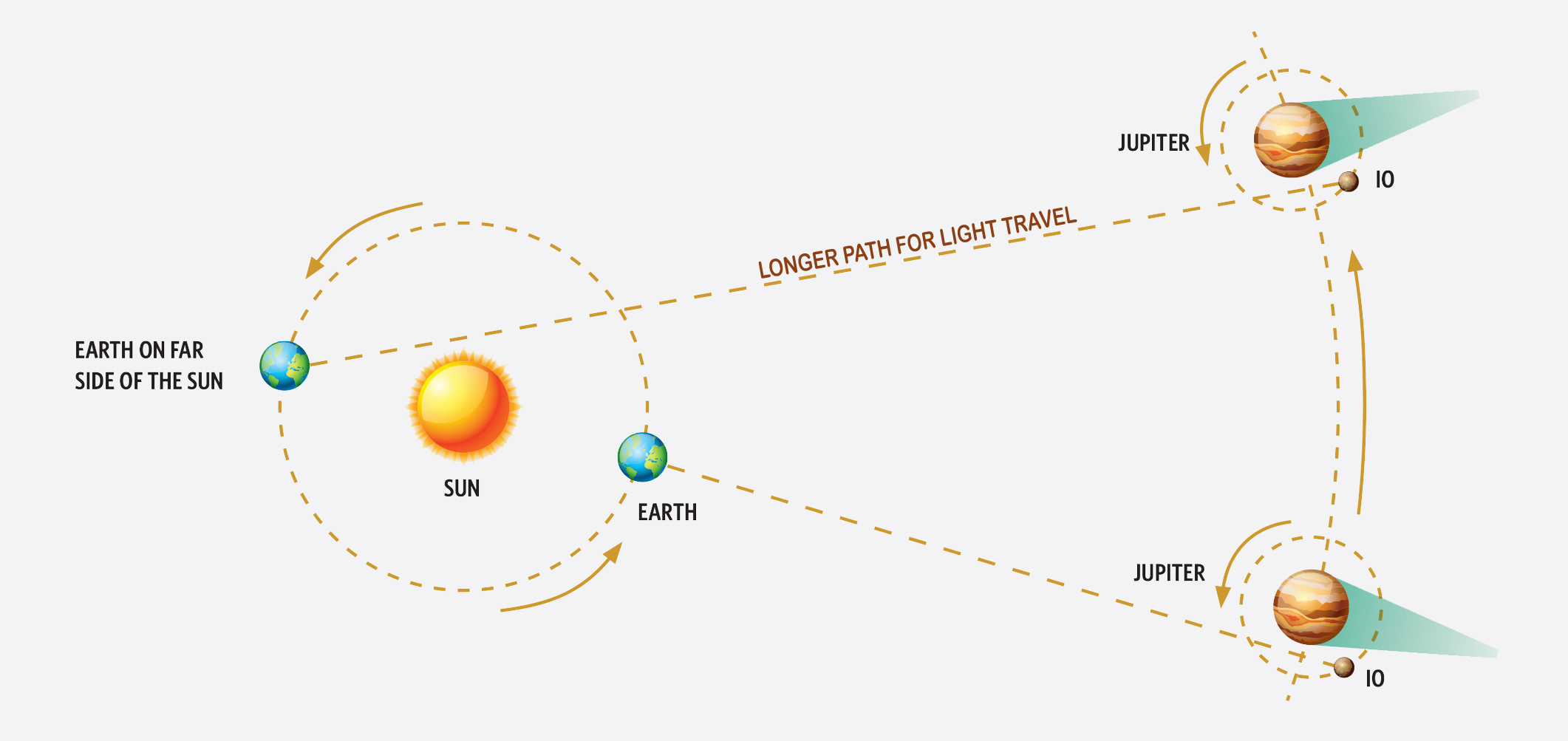 A schematic showing the reasoning used by Roemer (modified by author, source unknown)
A schematic showing the reasoning used by Roemer (modified by author, source unknown)
Measure it Yourself!
Could we verify the same now that we are at Opposition of Jupiter? You can start by picking your favourite satellite, or use Io just like Rømer. Identifying Io on any particular date may need you to have access to some charts or can be easily done by “zooming” to Jupiter via software like Stellarium. Be ready with your telescope or high power binoculars and an accurate clock. The aim is to record the exact time of occultation (disappearance) of Io. You will need to time the same satellite’s next disappearance too. It may be useful to remember that Io has an orbital period close to 42 hours. You will need to find out the approximate times and plan so that the next occultation is not lost because it happens when Jupiter is in the bright morning sky. Obviously, this is not a job for just 1-2 evenings and it may be great to do this for a few more occultations, so that it is possible to find the time of orbit more accurately.
This exercise of course has to be done at atleast two different positions of the Planet - once at Opposition and once when it is relatively in the same direction as the Sun, but the satellites are still visible (say at 45 degrees away from it). The angle between the Sun and Jupiter must be noted. Using standard trigonometry with this angle and the orbital radii of the Earth and Jupiter, we can calculate the distance between Earth and Jupiter. (Hint: cosine) Once we know the time period of the occultation, we can predict when it should happen close to any chosen date. The exciting part is to see how late it happens! You will need to identify Io and then wait for it to be occulted at a favourable time. The wait could last for days and would give you a taste of how perseverant one needs to be to do a useful astronomical observation. There should be a time discrepancy and you can then use it to find the speed of light. Check if you can better the speed of light got by Rømer (within 10% of its real value should be good). Most importantly - have fun and share the excitement with others by showing them Jupiter!
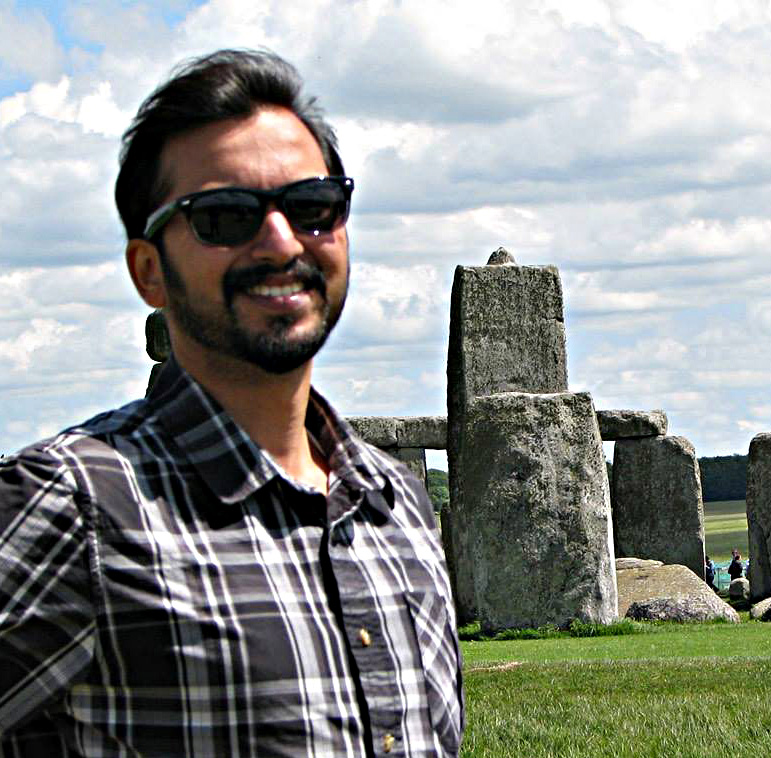 Samir Dhurde is in-charge of the popular outreach programme - SciPOP, at the Inter-University Centre for Astronomy & Astrophysics (IUCAA) in Pune, India. He believes that very simple methods can be used to make Science learning fun and to take scientific fervour to everyone. Trained as a Radio Astronomer, he loves to travel across his vast and beautiful country to work with children, share Astronomy with the people and inspire amateur astronomers to contribute to Science. Over more than a decade he has found himself under the hats of many EPO advisory groups such as the ASI-POEC, TMT-WEPOC, LIGO-India, ISRO-TOT, IAU-NOC etc. putting in efforts to design large-scale educational programmes and resources in India and abroad.
Samir Dhurde is in-charge of the popular outreach programme - SciPOP, at the Inter-University Centre for Astronomy & Astrophysics (IUCAA) in Pune, India. He believes that very simple methods can be used to make Science learning fun and to take scientific fervour to everyone. Trained as a Radio Astronomer, he loves to travel across his vast and beautiful country to work with children, share Astronomy with the people and inspire amateur astronomers to contribute to Science. Over more than a decade he has found himself under the hats of many EPO advisory groups such as the ASI-POEC, TMT-WEPOC, LIGO-India, ISRO-TOT, IAU-NOC etc. putting in efforts to design large-scale educational programmes and resources in India and abroad.
Email: [email protected]
A month for Jupiter!
By Samir Dhurde
Jupiter is a fascinating planet, being the envy of all others in its size. In fact it is also called a failed star - a gas giant that just missed the nuclear fusion bus, or else we on Earth could have had a Tatooine-like sunset scene sometimes. It is most of the time the 4th brightest object in our skies, only switching places for some time with Mars when the latter is at its closest to the Earth. Having been observed for millennia, it features in many human mythologies and cultural notes under so many names like Jove (Roman), Zeus (Greek), Bṛhaspati (Hindu), Al-Mushtari (Arabic), Mùxīng (Chinese), Mokusei (Japanese), Pirua (Incan) etc.
Opposition
It's a special Global Astronomy Month this year because on 8th April, 2017 the Earth was between the planet Jupiter and the Sun, placing Jupiter at "Opposition" to the Sun in our sky. One would see Jupiter rising above the horizon exactly at Sunset and would be able to see it throughout the night! Being at its closest position to the Earth during this period, Jupiter graces us with its brightest and undivided presence in the evening sky all this month and in the months ahead. So, let us note down a few ways to enjoy and make use of this opportunity.
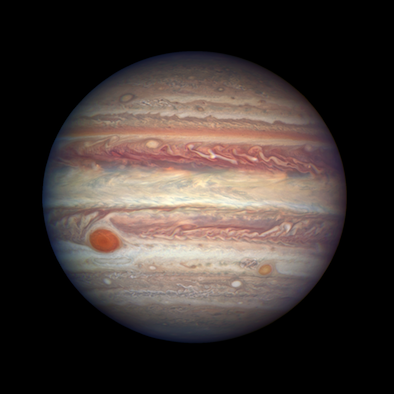 A dazzling capture of the face of Jupiter on this Opposition by the Hubble Space Telescope. (Credits: NASA, ESA, and A. Simon (NASA Goddard), Source: https://www.nasa.gov/feature/goddard/2017/hubble-takes-close-up-portrait-of-jupiter)
A dazzling capture of the face of Jupiter on this Opposition by the Hubble Space Telescope. (Credits: NASA, ESA, and A. Simon (NASA Goddard), Source: https://www.nasa.gov/feature/goddard/2017/hubble-takes-close-up-portrait-of-jupiter)
Peeking at Jove
One idea is of course to enjoy the view of the disc of the huge planet. For this you will need to have a small telescope at your disposal, at least similar to or bigger than what Galileo Galilee had used to take his paradigm-changing peeks at the "King of the Planets". When you look through your eyepiece, Jupiter’s profile will not look exactly circular. Jupiter is a gaseous planet and its equator bulges out due to its very fast rotation. The same also causes small, 10-hour days on this vast planet!
The face of Jupiter is quite dynamic because of this. There are two (or more if you are using a 6-inch or bigger telescope) brownish bands that you may catch on its cream-coloured disc. These darker cloud "belts" of Jupiter that appear between the lighter cloud "zones" are easy to spot. If you want a more challenging object, look for the famous Great Red Spot (GRS). This feature - a storm that is twice the size of the Earth, is quite elusive due to the fast rotation of the planet. With small telescopes, it could be difficult to identify unless it is right in the centre of the disc. Other than being small compared to the disc, it can become very pale and indistinguishable when it is at either of the edges.
The other enjoyable activities, while pointing your telescope to Jupiter, include observing the harmonious motions of the Moons of Jupiter. These firefly-like companions have been fascinating astronomers since Galileo discovered four of them — Io, Europa, Ganymede, and Callisto in 1610. Did you know that if it were not for their closeness to the bright Jupiter, all the "Galilean satellites" would be visible to the naked eye? Their visual magnitudes at opposition are - Io - 4.8, Europe - 5.2, Ganymede - 4.5 and Callisto - 5.5 , thus placing them well within the naked eye limit of around 6!
 Jupiter and its Moons through a 10-inch telescope. (Credit: Jan Sandberg, Source: https://commons.wikimedia.org/wiki/File:Jupiter-moons.jpg)
Jupiter and its Moons through a 10-inch telescope. (Credit: Jan Sandberg, Source: https://commons.wikimedia.org/wiki/File:Jupiter-moons.jpg)
|
It is quite easy to follow the positions of these Moons everyday with good binoculars or small telescopes (Galileo did it with a 2-incher!). Making a time-chart of their positions around the centre of Jupiter is a good project idea for those willing to spend some time everyday looking up. You will also be able to thus find out the time-periods of their revolutions around their gravitational commander. Obviously you will also sometimes catch these hovering in front of or disappearing behind Jupiter. Imagine how exciting it would be to be able to predict these transits and eclipses from your self-made time-chart. So start now! If planned early, you could also witness the rarer events where the moons occult or eclipse each other. All these make Jupiter a favourite for observers with small telescopes. Now that you know about them, this month is a great time to see & share these sights with everyone around you. In the continuation of this article, we will see suggestions for a very special project. |
|
Resources:
Of course sometimes you may have some urgent plans and may want quick predictions. There are several good sources online and offline. The following ones are particularly good.
Stellarium: An open-source planetarium software that shows a 3D simulation of the night sky. You can zoom in on Jupiter to see what the predictions of GRS or the moons are. Remember, Jupiter may look awesome in this, but what you will see through the telescope is the real thing!
Javascript Jupiter: A smart, web-based calculator for the Jupiter system, it gives you a picture of its current state at your location as well as predicts future moon events. Start observing ten or fifteen minutes early if you want to be sure of catching something.
 Samir Dhurde is in-charge of the popular outreach programme - SciPOP, at the Inter-University Centre for Astronomy & Astrophysics (IUCAA) in Pune, India. He believes that very simple methods can be used to make Science learning fun and to take scientific fervour to everyone. Trained as a Radio Astronomer, he loves to travel across his vast and beautiful country to work with children, share Astronomy with the people and inspire amateur astronomers to contribute to Science. Over more than a decade he has found himself under the hats of many EPO advisory groups such as the ASI-POEC, TMT-WEPOC, LIGO-India, ISRO-TOT, IAU-NOC etc. putting in efforts to design large-scale educational programmes and resources in India and abroad.
Samir Dhurde is in-charge of the popular outreach programme - SciPOP, at the Inter-University Centre for Astronomy & Astrophysics (IUCAA) in Pune, India. He believes that very simple methods can be used to make Science learning fun and to take scientific fervour to everyone. Trained as a Radio Astronomer, he loves to travel across his vast and beautiful country to work with children, share Astronomy with the people and inspire amateur astronomers to contribute to Science. Over more than a decade he has found himself under the hats of many EPO advisory groups such as the ASI-POEC, TMT-WEPOC, LIGO-India, ISRO-TOT, IAU-NOC etc. putting in efforts to design large-scale educational programmes and resources in India and abroad.
Email id: [email protected]
Communicating Astronomy with the Public (CAP 2018) Goes to Japan
By Lina Canas, on behalf of the Local Organizing Committee (LOC)
In 2018, the city of Fukuoka, in Japan, will host the largest conference in Astronomy Communication - the Communicating Astronomy with the Public (CAP) Conference, from 24 to 28 March 2018.
 Image I - The organisation has chosen 24 to 28, March 2018 as the dates for the conference, hoping to provide the full Japanese cherry blossom experience to all CAP 2018 participants.
Image I - The organisation has chosen 24 to 28, March 2018 as the dates for the conference, hoping to provide the full Japanese cherry blossom experience to all CAP 2018 participants.
CAP Conference series are organised by the International Astronomical Union (IAU), through Commission 2 - Communicating Astronomy with the Public. The IAU has more than 10,000 active members in 98 countries worldwide, and its mission is to promote and safeguard the science of Astronomy in all its aspects through international cooperation. Since 2003, CAP meetings have facilitated the exchange of ideas and best practices in Astronomy and Space communication and informal education. The Conference helps strengthen the local community of professionals by connecting them to the global network of Astronomy communicators and giving them access to the latest trends; lessons learnt and ongoing projects.
Consolidating the many Japanese efforts made in Astronomy Communication, the National Astronomical Observatory of Japan (NAOJ) and Fukuoka City teamed up to bring the international astronomy outreach and communication community to Japan. CAP 2018 is a call to all Science Communicators; Informal Educators; Professional & Amateurs astronomers; Public Outreach Professionals, Planetarium, Museum & Science Centers Professionals; Natural & Social Science Researchers; Journalists; Writers; Creatives and Artists - to gather in Japan and to share and experience the latest advances in the field. CAP 2018 will be a unique opportunity for meeting new professionals in astronomy communication face-to-face, and strengthen Japanese, Asian-Pacific and international relations.
 Image II - The brand-new Fukuoka City Science Museum on Japan's Kyushu Island has been chosen to receive the conference. The museum will open in October 2017 and will bring science to all Fukuoka’s citizens and visitors. It aims to make science accessible to the public and to provide an environment where children can express their creativity through fun and engaging science experiences.
Image II - The brand-new Fukuoka City Science Museum on Japan's Kyushu Island has been chosen to receive the conference. The museum will open in October 2017 and will bring science to all Fukuoka’s citizens and visitors. It aims to make science accessible to the public and to provide an environment where children can express their creativity through fun and engaging science experiences.
"Communicating Astronomy in Today’s World: Purpose & Methods" is the 2018 Edition theme, and different topics will cover a myriad of key aspects of communicating science in the present and ever changing societies. Ranging from the Current Challenges in Astronomy Communication; Best Practices in Public Outreach; Inclusion, Diversity, Equity and Empathy in Communicating Astronomy; Astronomy Communication for a Better World; Engagement with Astronomy; to the Media’s Role in Astronomy Communication: Using Multimedia, Social Media, Immersive Environments and other Technologies for Public. A Special Topic will be highlighted: Public Engagement Opportunities during the IAU Century Celebration, in preparation for the advent of the IAU 100th year anniversary celebrations in 2019.
CAP Japan will also represent a chance to know more about the cultural multiplicity Japan has to offer - the beautiful surroundings of the conference, the vibrant city of Fukuoka and the Island of Kyushu. We believe that immersing CAP participants in Japanese culture will benefit from a closeness that will reflect in future collaborations and strengthen the bonds with Asia and between themselves.
 Image III - CAP 2018 artwork is profoundly influenced by iconic Astronomy projects depicted in Japanese style drawings. Merging in one piece - the deep Astronomy roots from Japanese culture, to the state of the art high-tech Astronomy endeavours - all under one sky, one planet - celebrating the collaboration and support between the different people of Planet Earth.
Image III - CAP 2018 artwork is profoundly influenced by iconic Astronomy projects depicted in Japanese style drawings. Merging in one piece - the deep Astronomy roots from Japanese culture, to the state of the art high-tech Astronomy endeavours - all under one sky, one planet - celebrating the collaboration and support between the different people of Planet Earth.
We want to thank to Astronomers without Borders for the support since day one to our proposal of hosting CAP 2018 in Japan, and we hope that this collaboration can help to reach the international amateur astronomer's community, highlight and support the amateur astronomers highly impacting role in astronomy outreach around the world.
Registration for CAP 2018 will open on May 1, so please stay tuned for more news, as our team prepares to welcome you to - what we deeply hope! - will truly be a memorable and impacting experience for both the community and astronomy communication.
Official Site:https://www.communicatingastronomy.org/cap2018/
Social Media
https://www.facebook.com/CAPconference/
@CAPconference
 Lina Canas is currently based at National Astronomical Observatory of Japan in Mitaka, Tokyo working for the IAU Office for Astronomy Outreach. Throughout the years she has collaborated with many education and outreach associations in different projects, allowing her to know first-hand that the world is full of amazing people doing amazing things! Many of her hobbies overlap with her work, which sometimes is confusingly fun & confusingly stressing at the same time.
Lina Canas is currently based at National Astronomical Observatory of Japan in Mitaka, Tokyo working for the IAU Office for Astronomy Outreach. Throughout the years she has collaborated with many education and outreach associations in different projects, allowing her to know first-hand that the world is full of amazing people doing amazing things! Many of her hobbies overlap with her work, which sometimes is confusingly fun & confusingly stressing at the same time.
Solar Telescope on the Turquoise Coast
By Ajay Talwar
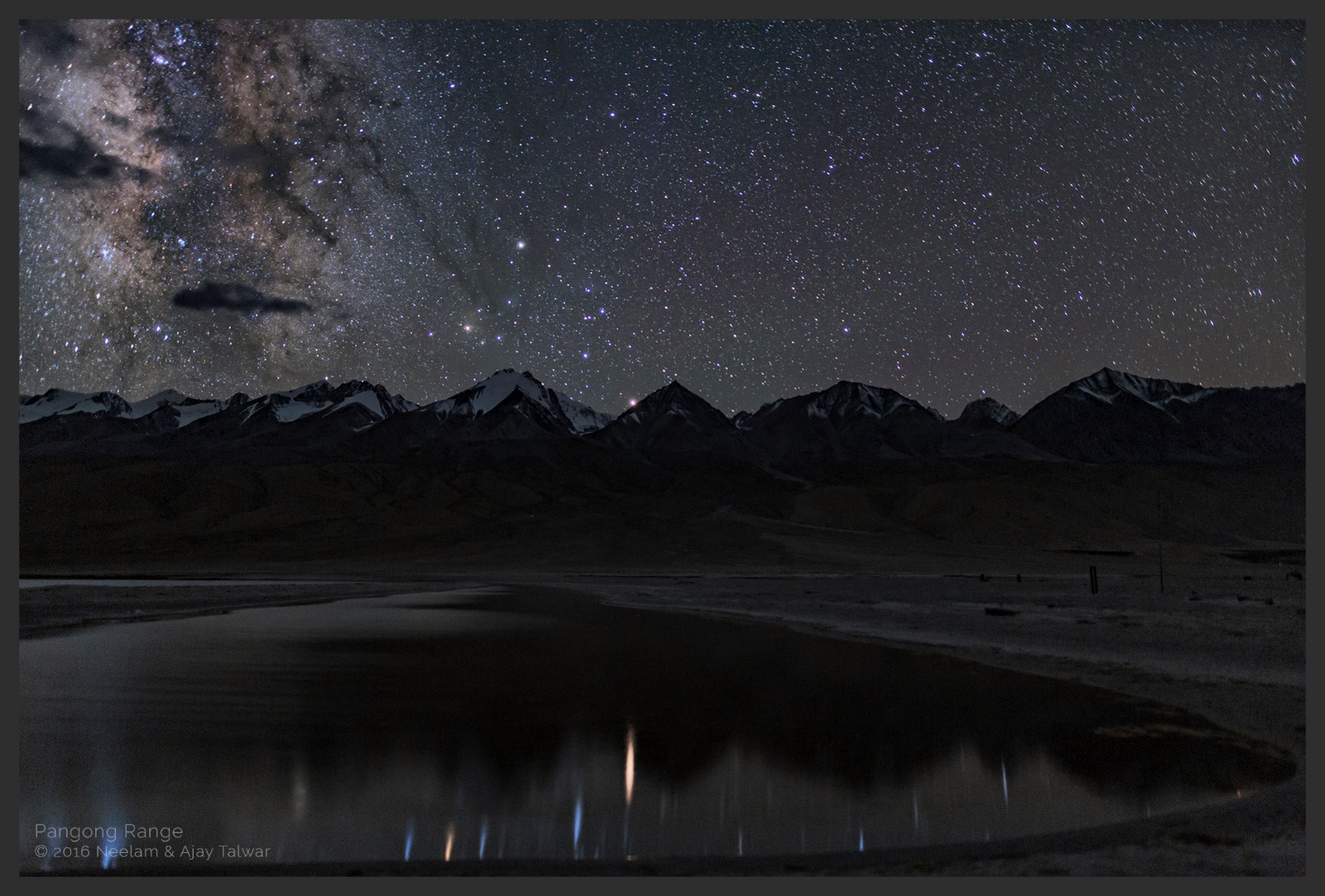
No I am not talking about the thousand kilometres of azure coloured sea coast in the Mediterranean Turkey, but a small lakeside coastline in the Himalayas. The water’s wonderfully clear showing multi-coloured pebbles at the bottom. The water shows different shades of turquoise, aquamarine, cerulean and many other blue hues during the afternoon when the Sun is high. The water turns into brown hues reflecting the surrounding mountains in the evenings. You could spend an entire lazy day watching the Pangong Tso waters change colours by the hour.
 The brackish, salty Pangong is the highest lake in Ladakh, at a height of 4300 metres and is flanked by massive peaks over 6500m high. The lake is 150 km long, but only 4-5 km at its widest. It extends way into Tibet, in fact, only a quarter of the lake is in India.
The brackish, salty Pangong is the highest lake in Ladakh, at a height of 4300 metres and is flanked by massive peaks over 6500m high. The lake is 150 km long, but only 4-5 km at its widest. It extends way into Tibet, in fact, only a quarter of the lake is in India.
Last year in July I spent several days and nights on the banks of Pangong – a lake in two countries. At night this remote place changes into a star studded arena. You simply cannot imaging that the sky could be so chock full of stars. On a moonless night it seems like you can reach out and touch the Milky Way. As you walk on the sandy shore it seems as if the Milky Way at the zenith is casting a shadow walking along and accompanying below you on the sand.
 Normally visitors and tourists to Pangong just make a day trip, Leh- Pangong-Leh. Just about touch the lake at Lukung and head back to Leh. The visitors feel tremendously happy, having reached this remote, and scenic location after crossing a high mountain pass. Seems like a pity since the lake is much more than just a shore at Lukung. Some of the tourists make it further and spend a night at Spangmik or Mann in the seasonal tented camp-hotels at these places. Head further and you reach a village called Merak.
Normally visitors and tourists to Pangong just make a day trip, Leh- Pangong-Leh. Just about touch the lake at Lukung and head back to Leh. The visitors feel tremendously happy, having reached this remote, and scenic location after crossing a high mountain pass. Seems like a pity since the lake is much more than just a shore at Lukung. Some of the tourists make it further and spend a night at Spangmik or Mann in the seasonal tented camp-hotels at these places. Head further and you reach a village called Merak.
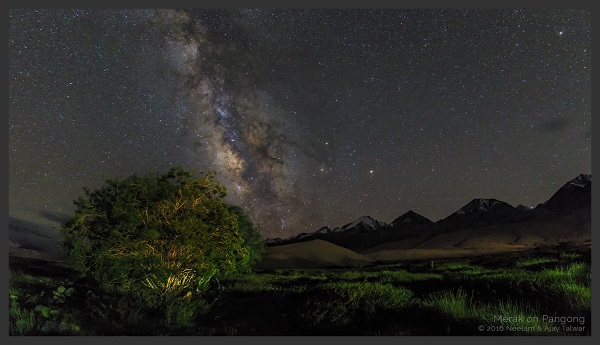
Merak is a beautiful oasis in a vast brownscape of Ladakh. The village is green with farming and square areas of forest plantations. Behind Merak you can see the Pangong range of mountains. The peaks are snow-capped all year round and feed the terrain with many streams. The streams are short and soon make it and feed the Pangong, but on the way sprouting a green oasis. Looking across the Pangong you can see mountains that lie in India and China. The Lake is divided in two countries.
 The Indian Institute of Astrophysics is well underway to install a solar telescope at this beautiful location of Merak. The upcoming telescope has been named ‘National Large Solar Telescope’ or NLST. There have been studies since several years to see if Merak is suitable for the Solar Telescope to be installed here. The site characterisation studies have found that Merak on the Pangong provides good number of sunshine hours with astronomical seeing. The seeing conditions are well suited for a large solar telescope. Plans are being made for a 2 metre solar telescope to be installed at a sandy peninsula jutting into the Pangong. When installed, this will probably be the largest solar telescope in the world. Currently there are couple of small telescopes installed at Merak peninsula, a bunker with computers, and a generator to run all the makeshift instruments.
The Indian Institute of Astrophysics is well underway to install a solar telescope at this beautiful location of Merak. The upcoming telescope has been named ‘National Large Solar Telescope’ or NLST. There have been studies since several years to see if Merak is suitable for the Solar Telescope to be installed here. The site characterisation studies have found that Merak on the Pangong provides good number of sunshine hours with astronomical seeing. The seeing conditions are well suited for a large solar telescope. Plans are being made for a 2 metre solar telescope to be installed at a sandy peninsula jutting into the Pangong. When installed, this will probably be the largest solar telescope in the world. Currently there are couple of small telescopes installed at Merak peninsula, a bunker with computers, and a generator to run all the makeshift instruments.
 During my visit to on the banks of Pangong Tso, I saw Andromeda galaxy rising from the hills plainly visible to the naked eye, billowing clouds, their moving shadows on the brownscape and the wind. Star studded night sky, bullet bikers on their personal epic ride of the life. Rdo Phungs or Tibetan Cairns in airy and sunny places, reflections of stars in the still waters of the lagoon beside the lake, the most perfect turquoise in the Pangong afternoon, beginnings of a grand solar observatory at Merak, the green oasis of Merak in the vast brownscape all around.
During my visit to on the banks of Pangong Tso, I saw Andromeda galaxy rising from the hills plainly visible to the naked eye, billowing clouds, their moving shadows on the brownscape and the wind. Star studded night sky, bullet bikers on their personal epic ride of the life. Rdo Phungs or Tibetan Cairns in airy and sunny places, reflections of stars in the still waters of the lagoon beside the lake, the most perfect turquoise in the Pangong afternoon, beginnings of a grand solar observatory at Merak, the green oasis of Merak in the vast brownscape all around.
At night I heard the roar of the Pangong waves beating against the stones. I also heard streams gently flowing from the melting snow and shortly meeting the lake waters, I saw numerous meteors, blaze across the sky, in their momentary brightness.
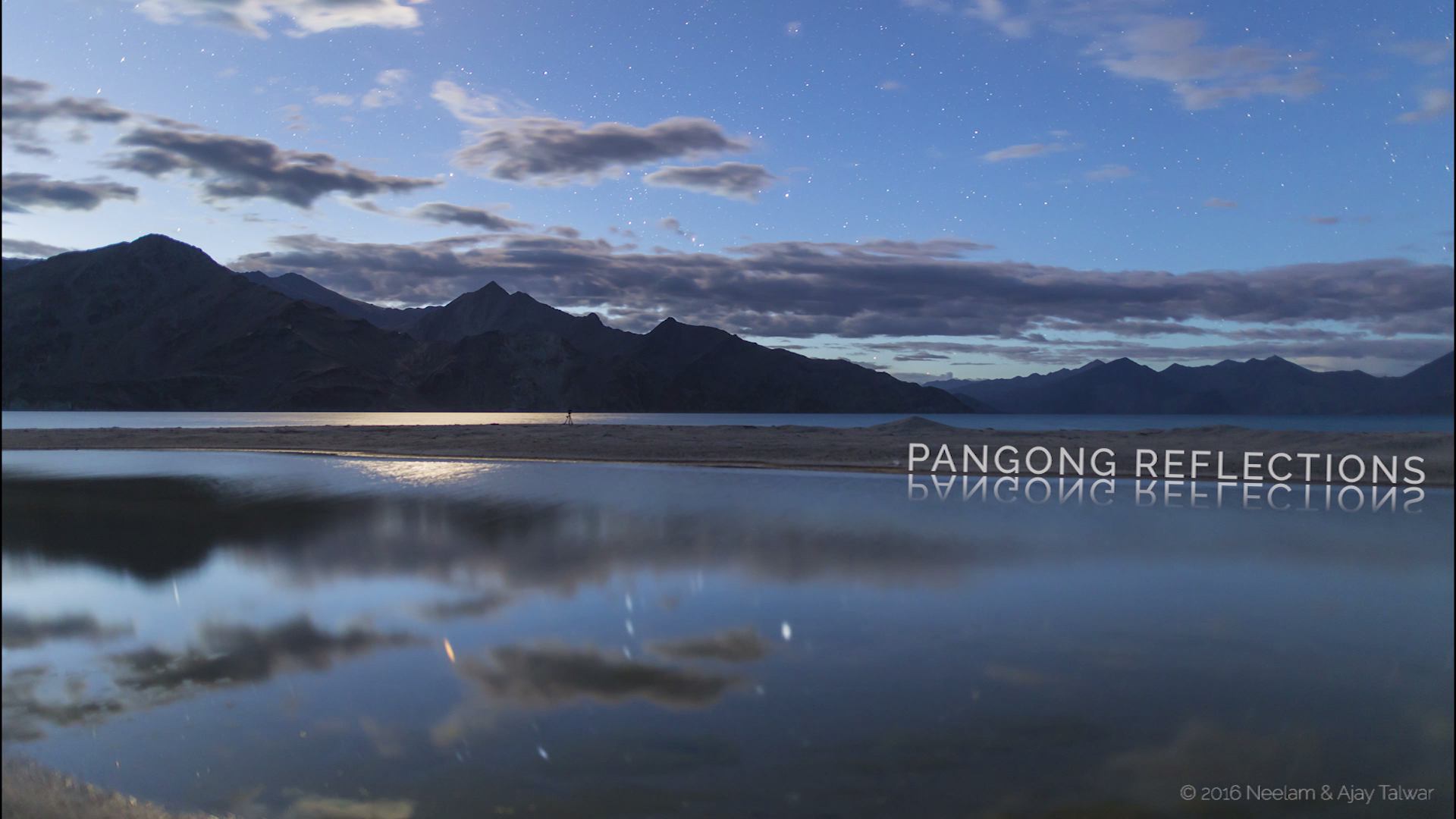
The movie can be seen at this link: https://vimeo.com/196929842
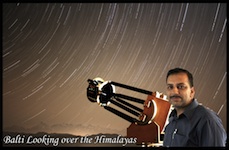 Ajay Talwar took up astrophotography in 1987 during a night when the Moon was occulting the Pleiades. Since then he has continued photographing the skies passionately. He is the most prolific transient sky events photographer in India. One of his early accomplishments was to produce an exhibition of all Messier objects along with three other Indian astrophotographers. Ajay travels with all his astrophotography gear to all across India, especially the Himalayas, places like high altitude Indian Astronomical Observatory at Hanle, Ladakh, high peaks in Himachal Pradesh. His interest to dark skies also take him to the white desert in the northwestern India.
Ajay Talwar took up astrophotography in 1987 during a night when the Moon was occulting the Pleiades. Since then he has continued photographing the skies passionately. He is the most prolific transient sky events photographer in India. One of his early accomplishments was to produce an exhibition of all Messier objects along with three other Indian astrophotographers. Ajay travels with all his astrophotography gear to all across India, especially the Himalayas, places like high altitude Indian Astronomical Observatory at Hanle, Ladakh, high peaks in Himachal Pradesh. His interest to dark skies also take him to the white desert in the northwestern India.
Ajay Talwar regularly holds astrophotography workshops, including practical programs in the Himalayas where participants are provided necessary equipment to photograph the sky.
India is an enormous country of natural and cultural diversity. Through his TWAN contribution Ajay hopes to photograph many of India's heritage under the starry sky.
Ajay is blurring the sharp divide between scientific astrophotography and artistic photo-journalism. In 2011 he was invited to attend a month long residency by the Khoj International Artist’s Association. At the end of ‘Shifting Focus’ his work was exhibited at the Khoj Studios, New Delhi.





 A representative plot of the positions of Jupiter’s moons during the GAM2017 - made using the excellent online astronomy calculator at www.Calsky.com. (Copyright by Arnold Barmettler, source:
A representative plot of the positions of Jupiter’s moons during the GAM2017 - made using the excellent online astronomy calculator at www.Calsky.com. (Copyright by Arnold Barmettler, source: 